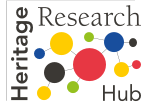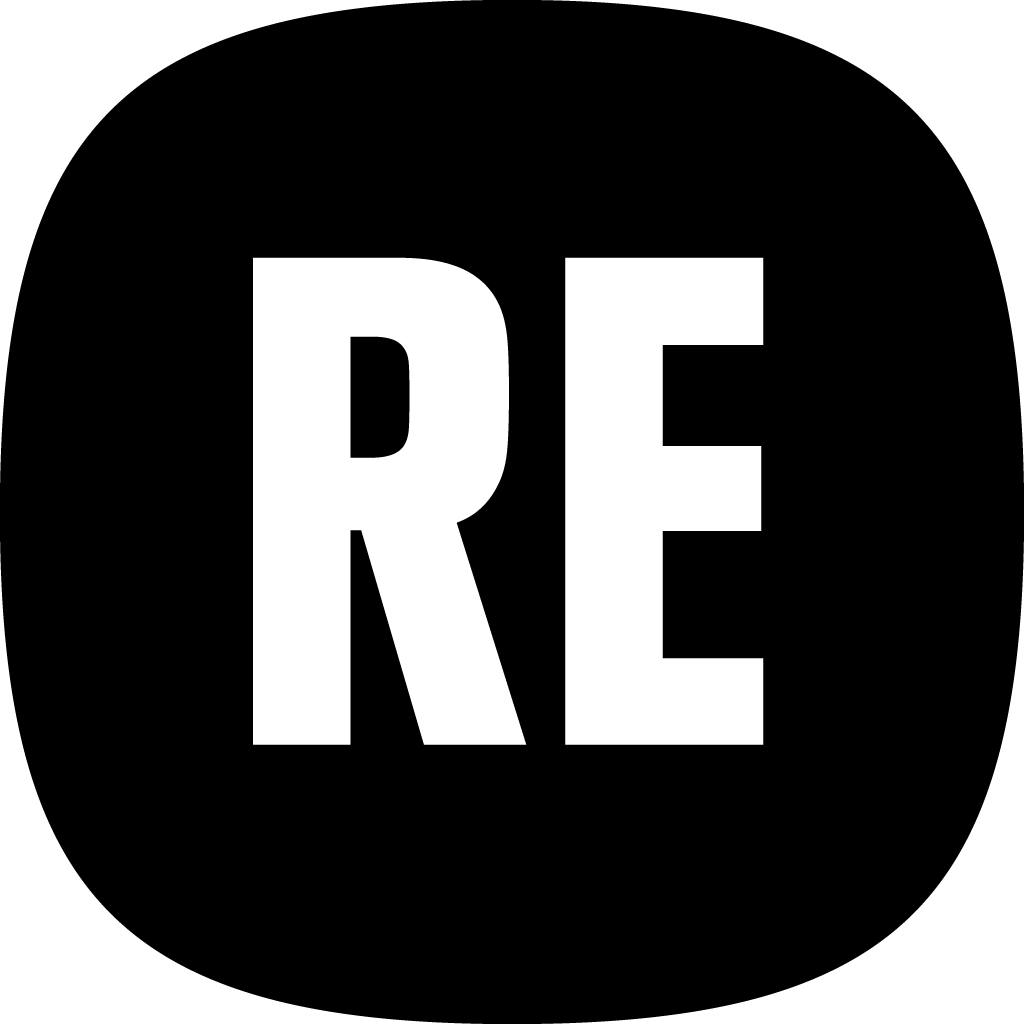Project facts
We believe that community participation can reinvigorate the cultural heritage sector across Europe. Since 2022, RECHARGE set out to support the sustainability of the sector by investing in the power of community participation with cultural heritage organisations (CHOs). After three years of collaboration, experimentation, and dialogue, with nine Living Labs —dynamic spaces where ideas and solutions are co-created, tested, and iterated by collaborating stakeholders— RECHARGE has developed a collection of practical tools and fresh perspectives to help shape a more resilient and connected sector.
It all begins with the RECHARGE Playbook, a practical guide offering ready-to-use participatory processes, empowering CHOs to embed inclusivity into their daily practice. Each additional resource is designed to deepen and enrich understanding of the concepts outlined in the Playbook and includes: graphic recordings, research documents, policy recommendations, and a collection of case studies sharing ‘Real Stories’ from Living Labs across Europe.
The RECHARGE Playbook
The RECHARGE playbook presents 3 Participatory Business Models for Cultural Heritage that can extend the existing operations or help introduce new services/products for CHOs. Included in the playbook are ready-to-use processes and examples of how to implement these business models using a Living Labs methodology.
RECHARGE CANVAS
Access a digital version of the RECHARGE Canvas for Participatory Business Models for Cultural Heritage.
OUR RESEARCH
Discover the RECHARGE project’s foundation: policy insights, innovative methods, and evidence-based research shaping inclusive cultural practice.
‣Allocating Value to Participatory Dimensions and Strategies by Museum Communities
‣RECHARGE Application of the four phases of participatory business models in heritage
‣RECHARGE Participatory Cultural Business Models Explained
‣Benchmarking Participatory Strategies
‣Typology of Participatory Practices in the Cultural Heritage Sector
‣Working Together for Cultural Heritage RECHARGE Recommendations for Sustainable Collaboration
REAL STORIES
Real voices. Real impact. Explore how cultural heritage organisations across Europe are reimagining their roles through participation, sustainability, and resilience.
Prato Textile Museum
WHO
The Prato Textile Museum, located in Tuscany, Italy, is a leading institution dedicated to preserving and promoting textile heritage. It plays a vital role in conserving historical textiles while fostering innovation in design and craftsmanship. Serving as both a museum and a research hub, it bridges the rich history of Prato’s textile production with contemporary practices. Through exhibitions, educational programs, and collaborations with artisans and textile industries, the museum actively promotes sustainability and the creative reuse of materials.
WHAT
The RECHARGE Living Lab at the Textile Museum of Prato is a strategic project designed to expand the museum’s digital and commercial presence. The project promotes sustainable and participatory business models for cultural institutions through the development of an e-commerce platform. This platform provides visibility and economic opportunities for young artisans, independent designers, and small museums. By collaborating with local creative communities—including artisans, designers, and small businesses—the museum’s e-shop enhances the visibility of handmade, sustainable, and local products (some of which are inspired by the museum’s collection) as well as exhibition catalogues, courses led by experts, and items from partner museums.
The e-commerce platform aligns with the museum’s sustainability goals by promoting local craftsmanship and materials primarily from the Prato and Tuscany region. Overall, the initiative fosters a vibrant and sustainable ecosystem for cultural entrepreneurship.
HOW
This Living Lab is brought to life through a multifaceted approach that integrates digital transformation, participatory design, and community-centered co-creation. The museum’s e-commerce platform was developed over a year through co-ideation and co-creation sessions with local communities, including artisans, designers, small businesses, other museums, and potential users. These workshops focused on ideating, designing, and testing the e-shop concept as well as its product and service offerings..
The platform has already captured significant interest, receiving its first purchase orders and positive feedback. Community workshops held in February 2024 provided valuable insights into user experience and helped the museum refine the platform and further develop its offerings to better serve its audience. These sessions highlighted the value of storytelling and artisan background, as well as the appreciation of the craftsmanship and unique identity of the products. The museum’s mediation ensures that the products are seen as high-quality and refined, boosting their perceived value.
During the second year of the project the museum has been working on expanding the museum’s network of artisans, developing new product and service offerings, implementing some technical adjustments and enhancing the online brand through strategic marketing and promotion plans. Partnerships with institutions like IED (European Institute of Design) and ISIA (Higher Institute for Artistic Industries) have also helped to develop new products targeted at younger, gender-neutral customers.
With the support of external marketing agencies and internal workshops, the museum aims to improve the platform’s usability and enhance its visibility, ensuring long-term sustainability of the project. Through this participatory model, the Textile Museum of Prato is setting a strong example for how cultural institutions can create economic and social value together with creative local communities.
PROBLEM SOLVED
One of the initial challenges faced by the museum was effectively engaging a diverse group of stakeholders. This required dedicated outreach efforts and a clear communication of mutual benefits to encourage active participation in the co-creation workshops. Additionally, the museum has been working to develop new skill sets in areas such as e-commerce management, and digital marketing, which involves both internal staff training and reliance on external expertise.
The unique nature of the handcrafted products presented ongoing challenges related to visual presentation, inventory management, and conveying the individual stories behind each artisan. When the museum began to engage with other cultural institutions as product suppliers, it encountered the complexity of acting as a sales intermediary between the end user and additional intermediaries, such as small museums.
Looking ahead, the museum has recognized the importance of exploring diverse revenue streams and refining its operational model based on user feedback and sales data collected during the testing phases. These ongoing efforts are essential to ensuring the long-term viability and impact of the e-shop.
Estonian Maritime Museum
WHO
The Estonian Maritime Museum, located in Tallinn, is one of Estonia’s premier cultural institutions, dedicated to preserving and promoting the country’s rich maritime heritage. It serves as a hub for maritime education, research, and public engagement, offering a range of exhibitions, educational programs, and initiatives that deepen understanding of maritime history. As part of its commitment to innovation, the museum integrates modern technologies into its operations, ensuring that its offerings remain relevant to contemporary audiences. It also plays an active role in reshaping the cultural heritage sector by pioneering new approaches to collaboration and technological integration.
WHAT
The Estonian Maritime Museum is leading an innovative co-creation initiative that fosters collaboration among cultural heritage institutions (CHIs), the tech sector, and educational organizations. This initiative focuses on developing tailored digital solutions for museums, such as ticketing systems, interactive exhibitions, visitor tracking, and educational tools. Instead of relying on off-the-shelf products or solutions, the museum takes an active role in the development process by working closely with developers and educators to ensure that the resulting products meet the specific needs of the museum and its visitors. This approach addresses key challenges in the cultural sector, including the demand for customized tools that enhance educational experiences and improve operational efficiency.
HOW
The museum’s co-creation process involves a strategic, multi-stakeholder approach. Key strategies include forming partnerships with tech companies, cultural institutions, and educators to ensure that the digital solutions are both innovative and applicable to the needs of the sector. The museum follows an open innovation approach, where it actively contributes to the development of these solutions by providing insights based on its expertise in maritime heritage and educational outreach. Additionally, the museum has developed internal training programs to equip its staff with the skills needed to participate in the creation of these technological solutions. The project also explores new business models, including profit-sharing arrangements, that ensure long-term sustainability and equitable risk distribution. Legal agreements are also put in place to address intellectual property concerns and financial contributions. The museum measures success through key performance indicators, such as the successful launch of co-created products and the development of a replicable business model for similar collaborations.
Through this innovative model, the Estonian Maritime Museum is not only advancing its own digital infrastructure but also demonstrating how cultural institutions can become active partners in technological innovation. By aligning its efforts with the growing tech sector in Estonia, the museum is helping position cultural heritage institutions as key contributors to the national digital economy.
PROBLEM SOLVED
The Living Lab process itself presented several challenges for the Estonian Maritime Museum. During the co-ideation phase, a lack of awareness regarding the potential of co-creation and a perceived sense of competition between museums initially hindered collaborative efforts. To address this, the museum organized dedicated sessions to explain co-creation principles and highlight the mutual benefits of partnership. In the prototype phase, the museum encountered technical limitations in sourcing and integrating accurate 3D models for their augmented reality (AR) educational tool. A significant pivot was also necessary when the initial plan to use students’ own devices for the AR solution proved infeasible due to technical requirements, necessitating a shift to providing museum-owned devices. The testing phase was constrained by the limited availability of AR devices and the need to refine instructional materials based on initial feedback from teachers and students. As the Living Lab moved into its second iteration, unforeseen budget cuts within the Estonian museum sector ultimately led to the discontinuation of their planned collaborative project, underscoring the financial vulnerabilities faced by cultural institutions in pursuing innovative ventures.
Hunt Museum
WHO
The Hunt Museum, located in Limerick, Ireland, is a prominent cultural heritage institution known for its diverse collection of over 2,000 objects, ranging from artworks to archaeological artifacts. Its mission is to promote cultural heritage, foster education, and engage the community through exhibitions and public programs. The museum plays a central role in Limerick’s cultural landscape, working to make its collections accessible to the public while exploring sustainable practices and partnerships. The Hunt Museum’s forward-thinking approach includes its active involvement in the RECHARGE Living Lab process, which bridges the gap between cultural heritage, corporate collaborations, and community-driven initiatives.
WHAT
The aim of the Hunt Museum Living Lab was to make a partnership with a corporation to use their Corporate Social Responsibility (CSR) budget to solve a museum challenge, involving local communities in a project that could be sustained over time.
The RECHARGE Model that the Hunt Museum chose to test was the CSR cultural heritage community model: This business model fosters meaningful, long lasting connections between museums, active communities, and socially responsible companies. It engages companies to use their CSR programmes in innovative ways to benefit museums and their communities. By facilitating collaboration, this model develops innovative products and services that meet local needs. The Hunt Museum identified anti-social behaviour in the Hunt Museum Garden as a challenge to solve using participatory practices.
As part of the RECHARGE Living Lab initiative, the Hunt Museum has led an innovative project titled Weaving Willow. Fostering collaborative co-creation between local communities, the museum, and corporate partners, firstly with Cook Medical, and in a later iteration with SISK,the project aimed at solving the problem of anti-social behaviour in the Hunt Museum garden; focused on climate and biodiversity, as well as engagement with a heritage skill, wellbeing and local pride, thus bringing a shared value to all participants. By creating opportunities for community engagement in the weaving of willow to create sculptures in the locality, as well as offering skill development workshops the project enhances public engagement in cultural heritage while promoting environmental sustainability. It offers a platform for creating community-driven art that reflects local values and needs.
HOW
The implementation of the Weaving Willow project follows a structured co-creation approach, bringing together museums, corporations, and local communities to collaboratively design and produce the final output. The process began with co-creation workshops involving museum professionals, corporate partners, and local community members. These workshops identified the issues to address—such as anti-social behavior and biodiversity improvement in the museum’s garden—while ensuring that the needs and preferences of the local community guided the final project outcomes.
The project uses the Living Lab methodology, which encourages iterative co-creation and continuous feedback from stakeholders. A key partnership with Cook Medical in the project’s first iteration and SISK in the second provided CSR funding, ensuring the project’s financial viability. In addition to creating the Hunt Museum object replica sculptures, and a local willow sculpture storytelling walking trail, the project featured willow weaving workshops focused on employee wellbeing at Cook Medical, willow craft workshops for the broader community, and two temporary sculptures; one created by students from St. Gabriel’s School, and another Muc Dubh Hunt Museum object replica that is displayed in varying locations around the city
The project emphasizes transparency and collaboration, with all parties maintaining a balanced power dynamic and open communication. Success is measured by tracking metrics such as community engagement, employee participation, and the impact on local biodiversity. The Hunt Museum’s Living Lab process serves as a model for how cultural institutions can partner with corporations and communities to foster long-term sustainability and meaningful social impact.
PROBLEM SOLVED
The RECHARGE projects brought its own set of challenges across both iterations for the Hunt museum. A significant hurdle emerged during the first iteration (January 2023 – August 2023) with the unexpected withdrawal of the initial corporate partner. This required a considerable and time-sensitive effort to identify and secure a new corporate collaboration to maintain the project’s momentum and financial viability for its participatory activities with the community. Furthermore, the museum team faced the ongoing challenge of effectively engaging and maintaining relationships with corporate stakeholders throughout the entire Living Lab period. Even with community engagement being a core goal, the museum actively learned and adapted its co-ideation processes. Reflections from the first iteration highlighted the need for more effective mechanisms to involve the community from the very beginning, a lesson that informed the approach in the second iteration (August 2024 – September 2025). The need for consistent communication and follow-up with a diverse range of initial co-ideators, as well as the time required to build trust and meaningful relationships within the community, also presented ongoing operational considerations. In the second iteration, while a new corporate partner was secured, maintaining consistent engagement and being on time required careful navigation.
Serfenta Association
WHO
Serfenta Association is a Polish non-governmental organization based in Cieszyn, operating at the intersection of craft, culture, and entrepreneurship. With a team of two full-time staff, a business advisor, and several part-time craft instructors, Serfenta has over 17 years of experience in revitalizing traditional basketry through a modern, business-oriented lens. Accredited by UNESCO and recognized by awards such as the Europa Nostra Award and the Jeonju International Award for Promoting Intangible Cultural Heritage, Serfenta brings a unique perspective to the cultural heritage field by treating craft not as static tradition but as a living, evolving economic resource.
Their mission focuses on sharing and managing knowledge about intangible heritage—especially basketry—through education, participatory workshops, and innovative business practices. Known for their original “Innovation Model of Craft Revitalisation” (IMCR), Serfenta is a thought leader in using heritage to foster economic and social sustainability.
WHAT
Serfenta participated in the RECHARGE Living Lab to test how their IMCR model could be scaled and adapted beyond their own organization. Their main challenge was scaling: how to make their innovative model applicable to other contexts, institutions, and regions. The goal was to evolve their work into a more universal and adaptable service that could help others unlock the potential of their cultural heritage for social and economic benefit.
What began as a project to expand their internal model quickly grew into a broader initiative: HI! Heritage Impact—a new, expert-driven platform that offers tailored heritage-based solutions for cities, regions, and organizations. Instead of promoting one-size-fits-all tools, HI! provides customized frameworks based on the unique cultural assets and needs of each partner.
The initiative addresses key challenges in the heritage sector, including:
- Reframing tradition as a dynamic driver of innovation.
- Enabling cultural NGOs to diversify income streams through services.
- Empowering local communities to use heritage as a tool for identity, tourism, and economic growth.
HOW
Serfenta implemented their Living Lab through a structured yet adaptive process grounded in co-creation, expert collaboration, and real-world testing. Their methodology included:
- Building a Community of Experts: A group of seven women with backgrounds in culture, design, business, and research was formed. Together, they brainstormed scalable services and new approaches to cultural heritage.
- Design Thinking and Iterative Prototyping: Serfenta used tools like the Business Model Canvas and Otwarte Karty (Open Cards) to co-create ideas, explore market needs, and design the HI! Heritage Impact model.
- Real-World Engagement: Serfenta presented their evolving ideas at national and international forums (e.g. Masovian Heritage Forum, PICOBELLO project), which led to interest from organizations in Brazil and across Europe.
- Feedback Loops: Key insights—like the realization that external stakeholders needed adaptable tools rather than a fixed model—were integrated back into the project, resulting in a pivot from the Serfenta model to the standalone HI! concept.
- New Brand and Website: A new platform—hiheritage.com—was launched to showcase the offer and begin piloting solutions with external partners.
- Sustainability Strategy: Recognizing the need for further funding, Serfenta successfully applied for the Polish National Recovery Fund to complement RECHARGE support, enabling them to scale up their activities.
Key Outputs Include:
- HI! Heritage Impact service offer.
- A new, dedicated website.
- Tools and frameworks for research, innovation, and design in the heritage sector.
- A growing network of clients and partners across sectors.
PROBLEMS SOLVED
Through RECHARGE, Serfenta addressed several critical issues:
- Economic Sustainability: Developing a market-ready service portfolio supported by dual funding streams (grant and entrepreneurial income).
- Scalability: Transitioning from an internal innovation model to a versatile, scalable service.
- Visibility and Positioning: Rebranding from a basketry-focused NGO to an interdisciplinary heritage innovation hub.
- Stakeholder Engagement: Building a broader community of clients and partners through meaningful engagement and participatory development.
KÖME
WHO
KÖME – the Association of Cultural Heritage Managers – is a nonprofit organization based in Budapest, Hungary, dedicated to rethinking and revitalizing cultural heritage through participatory, ecological, and community-rooted approaches. Since its founding in 2012, KÖME has brought together a dynamic network of professionals, artists, and activists working across the fields of cultural heritage, education, and environmental awareness.
With a small core team and over two dozen active members (25 members consisting of the general assembly of the association), KÖME promotes collaborative, horizontal work structures and holistic thinking. Its members regularly engage with communities, artists, local governments, and educators to foster sustainable heritage practices and social cohesion. A key initiative in recent years has been Internép, an emerging heritage and community space in Budapest’s culturally diverse 8th district, co-developed with the artist collective Pneuma Szöv.
WHAT
KÖME’s RECHARGE Living Lab focused on transforming Népszínház Street – a historically rich but socially fragmented urban area – into a vibrant, participatory cultural corridor. Their aim was to build a collaborative local network, develop shared resources, and empower residents as co-creators of heritage and community.
The initiative addressed challenges such as social fragmentation, lack of shared public resources, and underuse of heritage spaces. In response, KÖME used Internép, a living lab for experimentation, dialogue, and collective action. The project sought to cultivate a sense of ownership among residents and collaborators, activate the public realm, and plant the seeds for a new, eco-conscious community institution.
Through regular “Visionary” meetings, thematic workshops, artistic performances, and street interventions, KÖME catalyzed relationships among artists, residents, local institutions, and changemakers. They fostered engagement around shared goals: greener streets, stronger social ties, and more democratic access to culture.
HOW
KÖME’s approach was firmly rooted in participatory methods and co-creation, transforming how heritage is conceived and experienced. Throughout 2024, they hosted over 15 public events and workshops, gradually weaving together the Népszínházvíziós Group (People’s Theatre Visionary Group). This dynamic network then actively co-designed key initiatives, including a practical “Library of Things” for resource sharing without financial exchange, and a vibrant Season Opening festival, a joyful neighborhood celebration.
KÖME’s team prioritized openness, letting community energy and grassroots proposals organically shape the outcomes. This approach cultivated new core team members, expanded local ownership of the Internép space, and fostered a shared narrative around urban sustainability and cultural empowerment.
Challenges and Lessons Learned:
Pioneering such a participatory process wasn’t without hurdles. KÖME readily admits that truly empowering a community demands significant capacity. They addressed this by providing ample space for people to contribute, distributing the workload and enriching the process. They also recognized the need for deeper mapping of street users and clearer communication about their evolving visions.
A key finding was that people on the street often react directly to spontaneous happenings and connect in diverse ways, highlighting the need for varied engagement strategies. The project also revealed that “greening” and alternative public space usage, while desired, can sometimes be conflicting issues, emphasizing the importance of ongoing dialogue.
Ultimately, the Living Lab methodology proved instrumental in forging meaningful relationships with stakeholders, enabling KÖME to achieve significantly deeper cooperation and collectively develop practical tools like the “Library of Things.”
Pinacoteca e Museo Civico di Palazzo Minucci Solaini
WHO
The Pinacoteca e Museo Civico di Palazzo Minucci Solaini is a civic museum located in Volterra, a small town in Tuscany, Italy. Owned by the local government, its mission is to shift from a tourist destination to a dynamic cultural hub for the local community. The museum, managed by a small staff and supported by volunteers, has a unique focus on engaging its citizens, particularly the youth population. It has a history of launching participatory initiatives to redefine its role in the community and make its rich historical collection, especially the masterpiece The Deposition by Rosso Fiorentino, more relevant to modern audiences.
WHAT
The “Pinacoteca: an Urban Cultural Laboratory” initiative aimed to transform the museum into a creative space for the community, especially young people aged 12 to 25. The project’s goal was to use participatory practices to unlock local resources and skills, fostering a new cultural ecosystem. The central challenge was to make the museum a place of belonging and cultural experimentation rather than just a historical archive. The project addressed this by co-designing a series of collaborative workshops and activities around a single, iconic masterpiece, The Deposition.
These activities, titled “il ROSSO,” were designed to:
- Promote community engagement and a sense of belonging.
- Identify and support youth-led artistic expression.
- Create a permanent network of artists, stakeholders, and institutions.
- Secure alternative funding to reduce reliance on public funds.
HOW
The Pinacoteca utilized a Living Lab methodology by involving a diverse group of stakeholders, including teachers, artists, musicians, and students, in co-designing and testing the project.
Here’s a breakdown of how they executed their vision:
- School Collaborations: The museum partnered with local middle schools, an art high school, and a technical institute. Students from these schools created various products, from a “Personal Book” that encourages a slower, more interactive visit, to “Vodcasts” (video podcasts) that share curiosities about the art.
- Multisensory Workshops: The “il ROSSO” series included four main workshops: I suoni del Rosso (The Sounds of Red), Le visioni nel Rosso (Visions in Red), I colori del Rosso (The Colors of Red), and I sapori del Rosso (The Flavors of Red). These activities allowed for a reinterpretation of the artwork through music, visual arts, and even a fundraising dinner inspired by the painting’s colors.
- Innovative Use of Space: The project experimented with transforming museum spaces. Underutilized areas, such as the cellars, were used for an exhibition of the students’ work.
The project faced challenges with bureaucratic delays from the municipal administration and a short timeline for a volunteer-led initiative. However, the Living Lab methodology helped establish a new, collaborative relationship between the schools and the museum, securing alternative funding, and generating significant community interest. The long-term plan is to make the museum a permanent urban laboratory, with dedicated spaces and financial autonomy.
Museum of Modern and Contemporary Art of Trento and Rovereto
WHO
The Mart, Museum of Modern and Contemporary Art of Trento and Rovereto, is a public cultural institution in Italy. Founded in 1987, it operates from three locations and houses a collection of around 20,000 works of art spanning from the 19th century to the present. The museum’s mission is to make its collection and research accessible to the public, with a focus on education and participatory practices. It’s unique in its commitment to co-design and collaboration, a methodology the museum has been refining through various projects to build long-term relationships with its community.
WHAT
The Mart’s Ways of Perception initiative is a project that uses art to explore “altered states of consciousness” in a healthy, creative, and transformative way. The project aims to move beyond traditional, passive museum experiences by developing interactive, multisensory tools that engage visitors. By collaborating with a high school and local tech companies, Mart sought to make its collection more accessible to younger audiences and find new ways for the public to connect with art.
The core challenge the project addresses is how to create a deeper, more meaningful connection between visitors and artworks. Instead of viewing art as a static object, the initiative explores how sensory stimuli—such as sound, touch, and sight—can create immersive experiences that open up new perceptions and emotions.
HOW
The Mart implemented the project using a Living Lab methodology, a collaborative approach that involved stakeholders in every step, from ideation to testing. This process was key to creating a shared sense of ownership and ensuring the final products were both meaningful and useful.
Here’s a breakdown of the key collaborations and outcomes:
- With Professor Nicola De Pisapia: Mart partnered with a cognitive neuroscience professor to ground the project in scientific research on altered states of consciousness, providing a unique interdisciplinary foundation.
- With the MaDe Manufactory Design Institute: A class of high school students co-created four low-tech prototypes that engage the senses. For example, they paired specific artworks with sensory experiences, such as a scent linked to a painting of vegetation or a tactile experience with a portrait.
- With Local Tech Companies: The museum collaborated with two local companies, Bookelot and Level Up, to develop high-tech immersive experiences. This included two virtual reality (VR) experiences and one augmented reality (AR) experience, shifting the project’s direction and introducing a new medium for engaging with art.
The Living Lab approach fostered open dialogue and mutual investment among all partners. The museum learned that taking the time to actively listen and understand each partner’s motivations is crucial for building trust and ensuring a project’s long-term success. The project’s sustainability will be ensured by integrating these high- and low-tech tools into the museum’s permanent collection and developing new workshops for school groups.
Museum of Architecture and Design
WHO
MAO is Slovenia’s national museum for architecture and design, situated in Fužine Castle on the outskirts of Ljubljana. Founded in 1972, MAO is one of Europe’s oldest institutions dedicated to architecture and design. Its mission is to preserve, promote, and reimagine architectural and design heritage while fostering contemporary discourse and community co-creation. MAO positions itself as a knowledge hub and meeting space for professionals, students, and citizens—blending preservation with participatory innovation.
The museum staff is supported by volunteers and external collaborators, and it plays an active role in testing new formats of engagement, particularly in making architecture and public space relevant to local communities. Prior to joining RECHARGE as a Living LAb, MAO had already launched its participatory initiative Museum in the Community, which laid the groundwork for its future Living Lab engagement.
WHAT
Museum in the Community: Transforming Public Space Through Participation
MAO’s Museum in the Community initiative reimagines the museum’s adjacent park (MAO Park) as a vibrant, co-created public space. The project addresses the disconnect between the museum and its local community, aiming to foster a sense of ownership, participation, and sustainability.
The initiative emerged from a simple question: Why is the park underused? Through community dialogues, clean-ups, co-design workshops, and collaborative interventions, the project has evolved into a long-term programme rooted in co-creation and local knowledge. It aims to overcome social fragmentation, encourage environmental stewardship, and increase the museum’s relevance within its neighbourhood.
HOW
Participatory Co-Design, Long-Term Relationships, and Living Lab Experimentation
MAO activated its Living Lab through a series of hands-on, participatory interventions and events across 2023–2025. These included:
- Co-ideation and co-creation workshops with youth centres, retired citizens, students, and architects to transform park elements (e.g. converting fallen trees into playgrounds, creating movable tables with board games).
- Collaborations with birdwatchers and students to explore the ecological role of public spaces and non-human park users, leading to educational trails and interactive learning tools.
- Inclusive tactile workshops (using wax and wool) with local elderly and general public to spark intergenerational dialogue and artistic expression.
- Sustainability-driven events on climate change, community gardening, and clothing exchange.
The participatory methodology helped develop three new educational programmes, nurtured cross-sectoral collaborations, and strengthened community identity and ownership over shared spaces. Challenges included navigating the limits of numeric evaluation in deeply human-centred projects and balancing diverse expectations, but these were overcome through transparent communication and flexibility.
PROBLEMS SOLVED
- Reduced vandalism by cultivating collective responsibility for shared spaces.
- Overcame barriers to museum accessibility by engaging people outside the museum walls.
- Activated underused public space through inclusive, bottom-up design.
- Built trust and long-term engagement between the museum and local stakeholders.
- Fostered environmental awareness and resilience through creative reuse and community gardening.
Hilversum Public Library & Heritage House
WHO
The Hilversum Time Machine working group is a collaboration between the Hilversum Public Library and the Hilversum Heritage House. The library is a community hub focused on reading and information, while the Heritage House is an association of over 10 local heritage organizations. The working group’s mission is to create a digital platform and a physical space within the new library building to connect residents with their shared local history. Their unique perspective is rooted in a belief that local history is for everyone, especially in a city with a significant population of people with migration backgrounds and expats.
WHAT
The “Hilversum Time Machine” is an initiative to create a digital and physical heritage hub that makes local history accessible and engaging for all residents. The project’s main goal is to use a participatory approach to build a sense of belonging and community, particularly among groups that are often underrepresented in historical narratives. The project aims to:
- Connect diverse heritage partners in Hilversum, leveraging the existing network of the Heritage House.
- Engage various community groups, including youth and people with migration backgrounds.
- Create a shared digital infrastructure for historical collaboration and exploration.
- Pilot the use of state-of-the-art technology, like AI and 3D visualizations, to enhance the heritage experience.
The core challenge is to go beyond traditional heritage work and actively involve a wide range of residents in discovering and sharing their own stories.
HOW
The project used a Living Lab methodology to guide its collaborative efforts. The working group met with numerous heritage partners to co-ideate the “Time Machine” concept. A key part of their strategy was to explicitly identify their target groups, which helped them focus their efforts on engaging with different communities.
- Building Partnerships: They successfully connected with other “Time Machine” initiatives in the Netherlands, sharing experiences and learning valuable lessons. This led to a large workshop in Amsterdam with around 80 attendees, which helped validate their approach and learn from others’ successes.
- Community Engagement: While some planned engagements with youth groups fell through due to time constraints, the team successfully met with a large group of active heritage volunteers (40 people). This feedback was crucial for shaping the project.
- Overcoming Challenges: The project faced several unforeseen challenges, including a key community group leaving the process and delays in the library’s design phase. The team addressed this by recruiting more volunteers and adapting their timeline, demonstrating a flexible and resilient approach.
A major outcome is the creation of a dedicated physical space for the Heritage House within the new library building and the development of a digital platform. The Living Lab methodology, by forcing the team to explicitly define and engage with different user groups, helped them build an active and motivated working group that is committed to the project’s long-term sustainability.
POLICY RECOMMENDATIONS
The future of cultural heritage is participatory. You can help shape it. Discover our policy recommendations for CHOs across Europe.
RECHARGE ACADEMY
Graphic recordings from the RECHARGE Academy, a week-long programme where we welcomed 20 senior professionals from across Europe’s cultural and creative sectors to dive into participatory practices and how to integrate them into their own work/organisations. Hosted 3-6 June 2025 at Erasmus University Rotterdam.
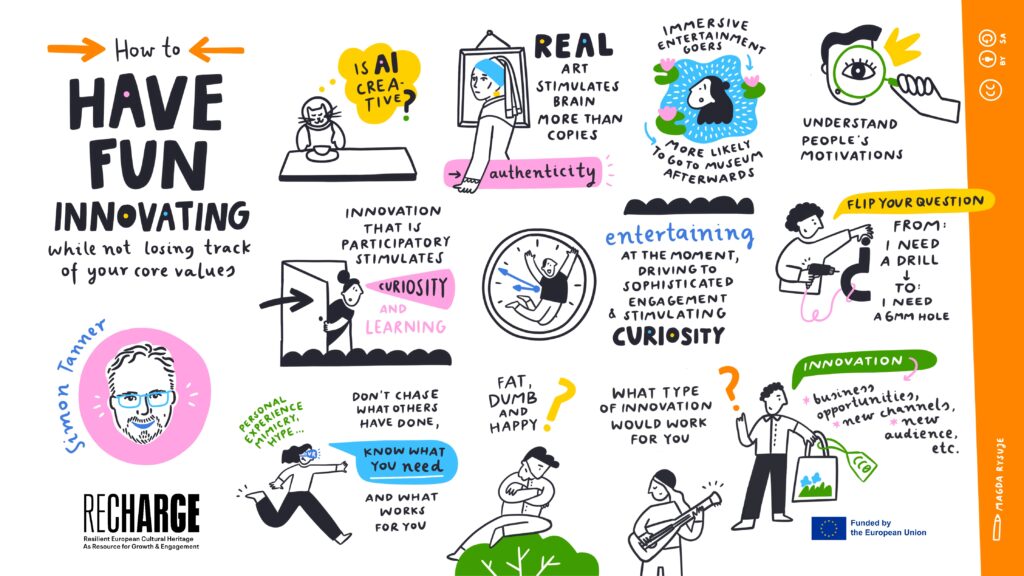
How to have fun innovating while note losing track of your core values
Keynote with Simon Tanner
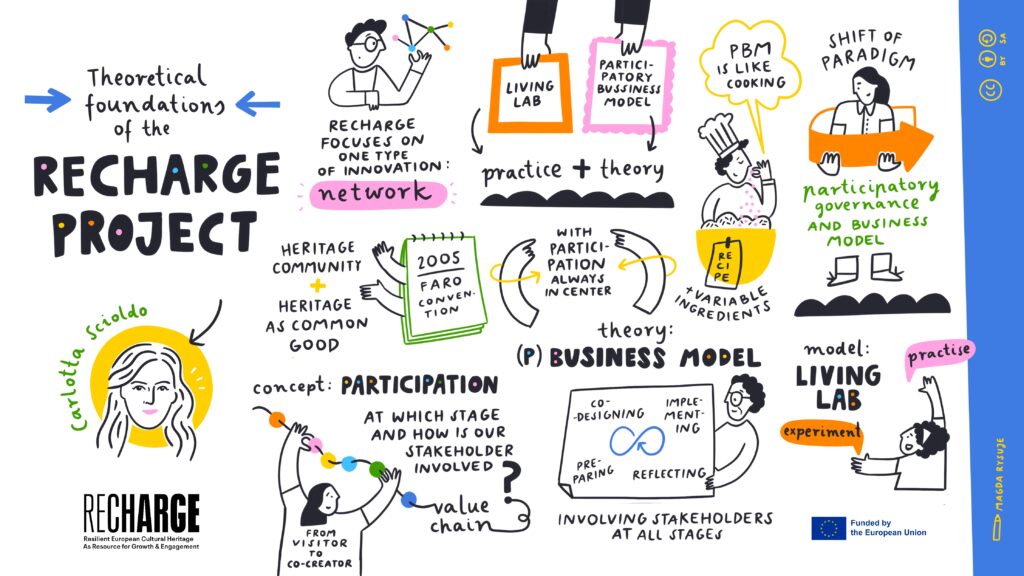
Theoretical foundations of the RECHARGE Project
with Carlotta Scioldo
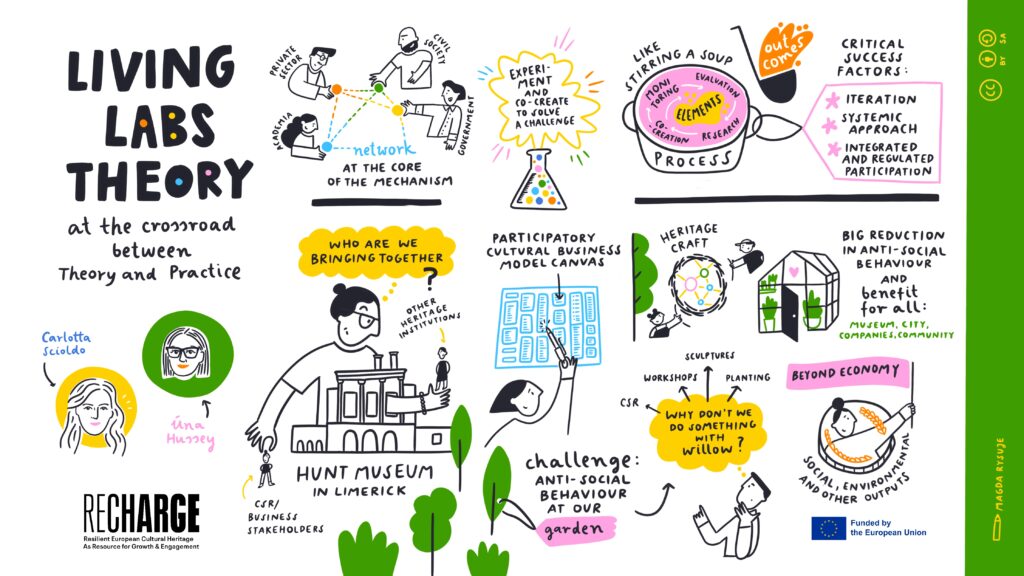
Living Labs Theory
with Carlotta Scioldo and Úna Hussey
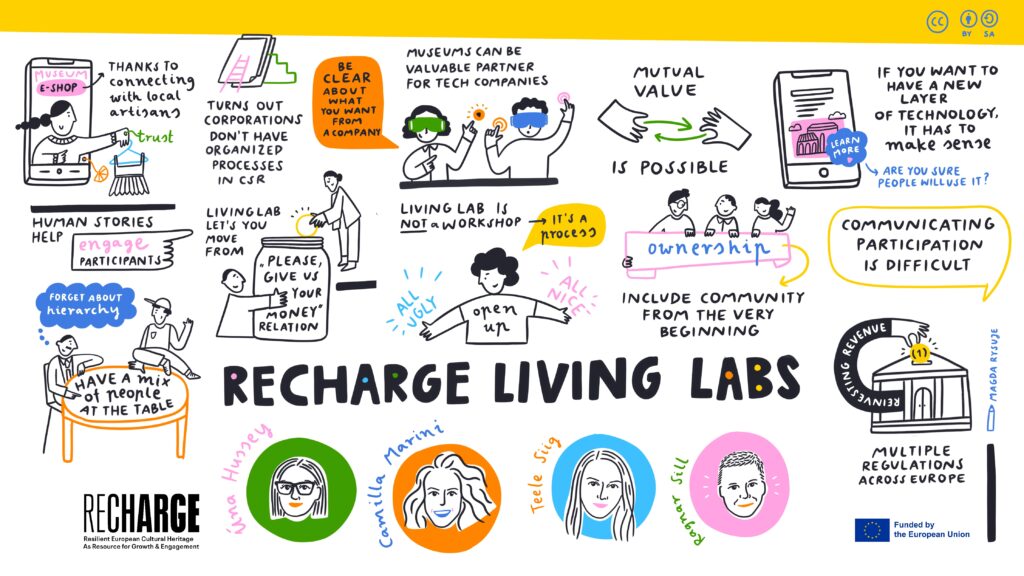
RECHARGE Living Labs
with Úna Hussey, Camilla Marine, Teele Siig, and Ragnar Sill
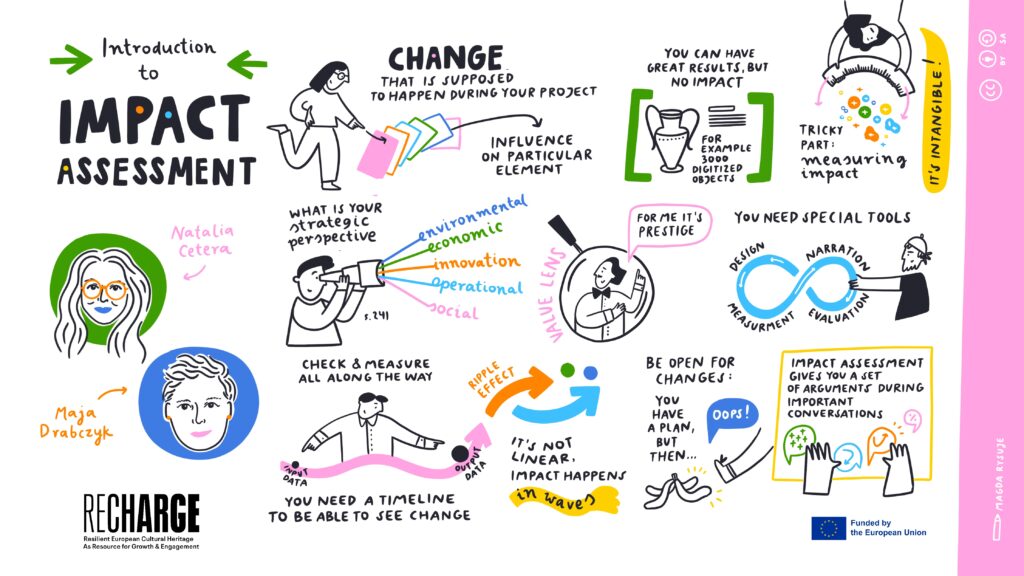
Introduction to Impact Assessment
with Natalia Cetera and Maja Drabczyk
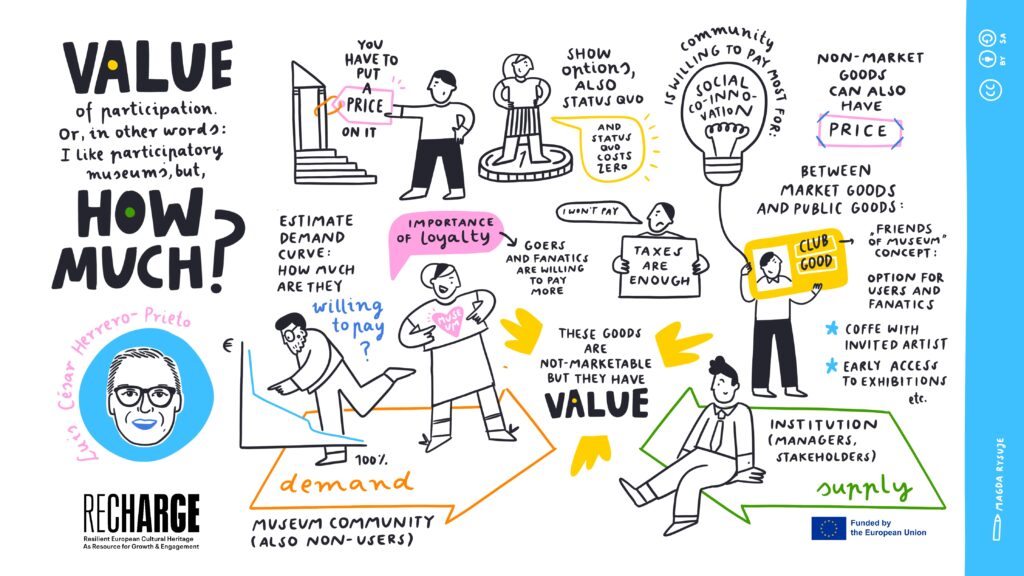
Value of Participation
with Luis César Herrero-Prieto
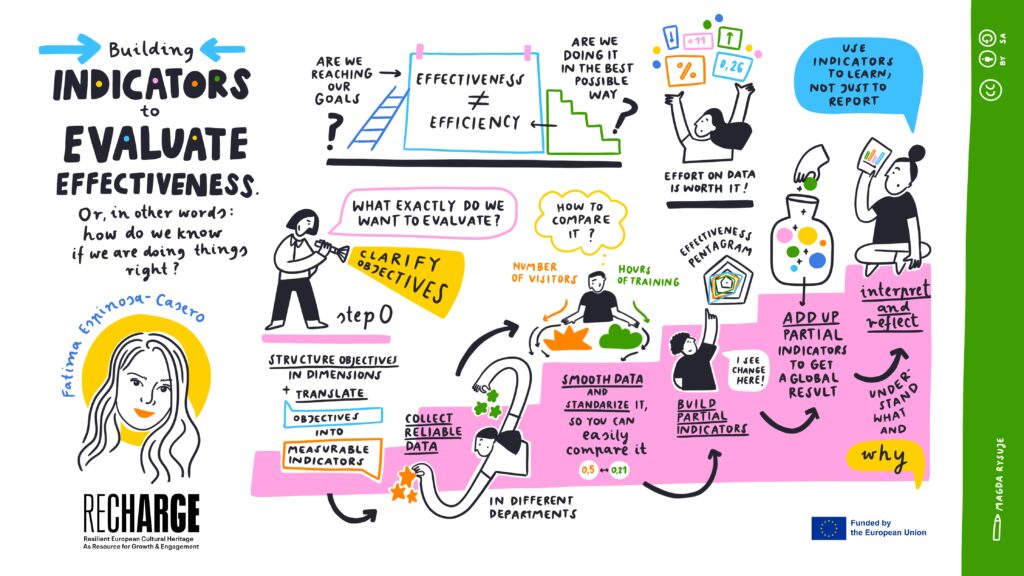
Building Indicators to Evaluate Effectiveness
with Fatima Espinosa-Casero
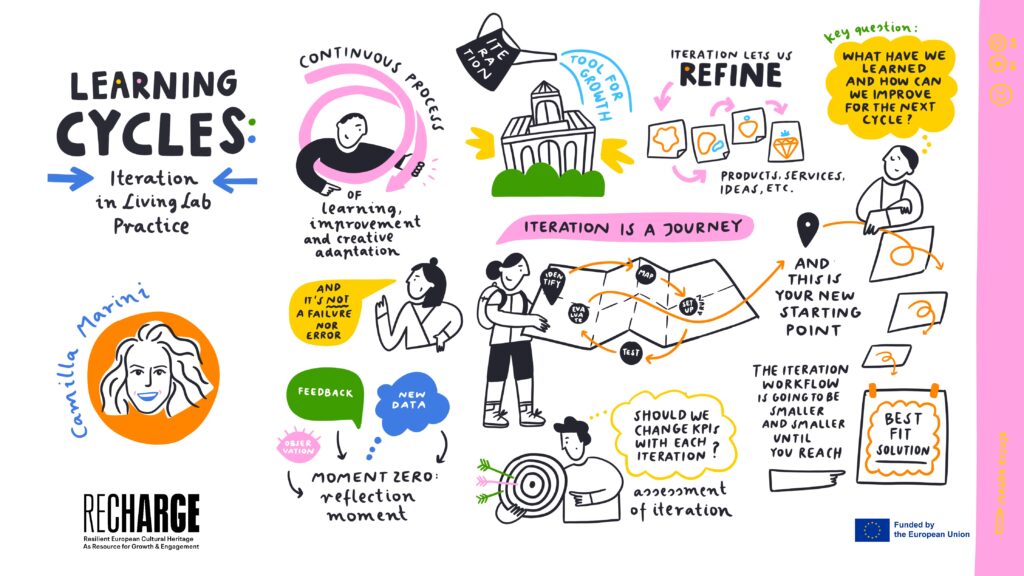
Learning Cycles: Iteration in Living Lab Practice
with Camilla Marini
